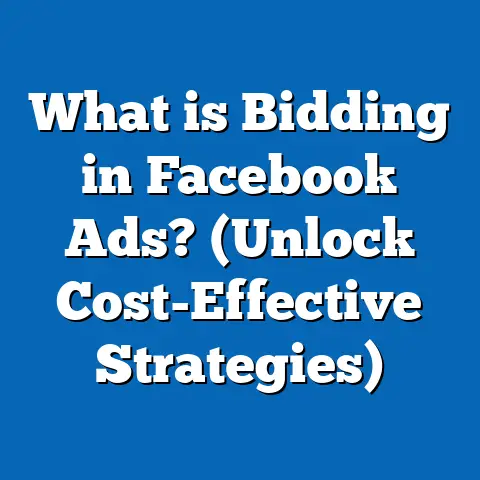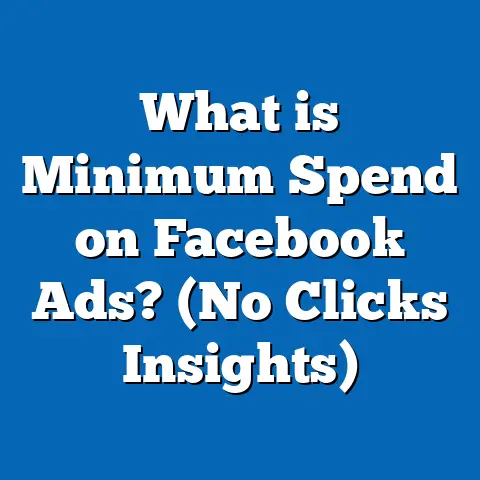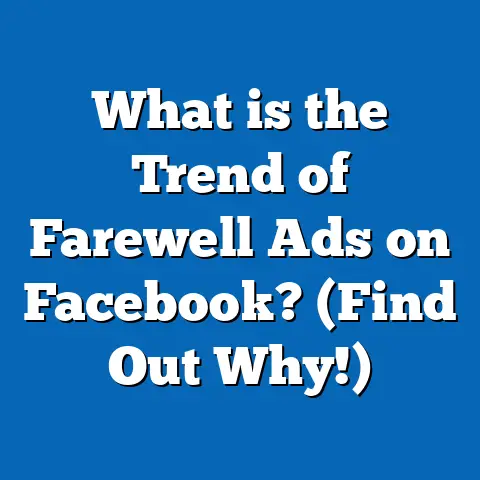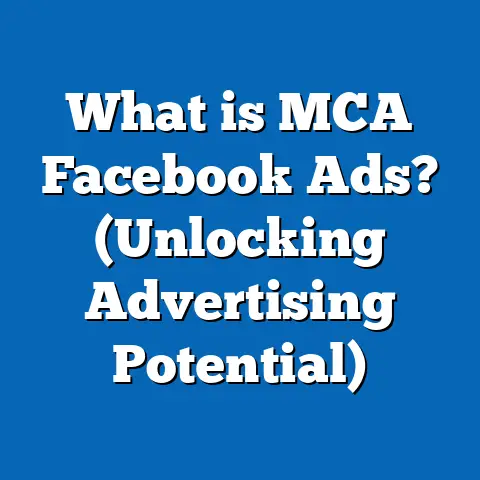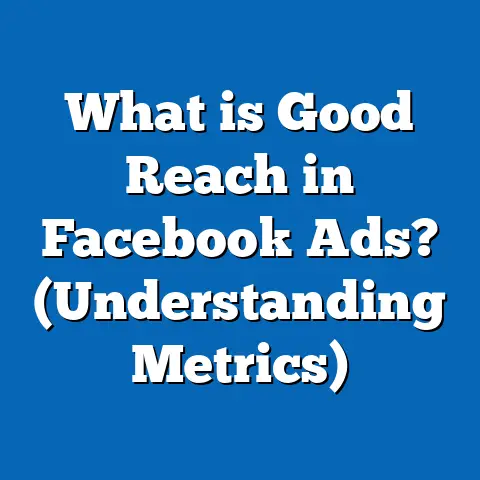What is Purchase Behavior in Facebook Ads? (Unlock Targeting Secrets)
Introduction: Budget Options in Facebook Advertising and the Role of Purchase Behavior
When launching Facebook advertising campaigns, one of the most critical decisions marketers face is budget allocation. Deciding how much to spend can feel overwhelming, especially with so many variables at play—audience targeting, ad creatives, bidding strategies, and campaign objectives. Fortunately, Facebook provides a flexible budgeting system allowing advertisers to choose between daily budgets and lifetime budgets. Daily budgets give you control over how much you spend each day, while lifetime budgets allow Facebook to optimize your spending over the campaign’s entire duration.
Regardless of budget size—whether you’re managing a modest $5/day campaign or a multi-thousand-dollar monthly budget—the success of your ads depends heavily on reaching the right people. Poor targeting wastes money, while precise targeting boosts conversions and ROI. This is where understanding purchase behavior in Facebook Ads becomes invaluable.
Purchase behavior targeting enables advertisers to connect with users based on their real-world buying habits and patterns. It empowers marketers to focus ad spend on audiences most likely to purchase, avoiding guesswork and inefficient broad targeting. This guide will thoroughly explain what purchase behavior means on Facebook, how it works, its benefits supported by data and case studies, and practical ways to apply it for your campaigns.
What Is Purchase Behavior in Facebook Ads?
Defining Purchase Behavior
In Facebook advertising, purchase behavior refers to a user’s past buying activities and habits as tracked and analyzed by Facebook through various data sources. This information is used to create segments of users grouped by their shopping preferences, frequency of purchases, spending power, and product interests.
Purchase behavior data is a subset of Facebook’s broader behavioral targeting options. Behavioral targeting uses information about users’ past actions—both on Facebook and external platforms—to predict future actions. Purchase behavior specifically focuses on how people buy: what they buy, how often, how much they spend, and when they tend to shop.
Why It Matters for Advertisers
Targeting audiences based on purchase behavior allows advertisers to:
- Reach high-intent buyers who are more likely to convert.
- Avoid wasting ad spend on users unlikely to make a purchase.
- Tailor creative messaging according to users’ buying habits.
- Increase overall campaign efficiency by optimizing for users with proven purchasing power.
In fact, Facebook’s own data suggests that ads targeted with purchase behavior insights perform significantly better than generic demographic or interest-based targeting.
How Facebook Collects and Classifies Purchase Behavior Data
Understanding where Facebook gets this purchase behavior data helps clarify its accuracy and reliability.
1. Facebook Pixel Tracking
The Facebook Pixel is a piece of code advertisers place on their websites. It tracks user actions such as page views, add-to-cart events, checkout initiations, and completed purchases. This data feeds into the behavioral targeting engine to identify users who have shown intent or completed transactions.
2. App Activity via Facebook SDK
Apps integrated with Facebook’s Software Development Kit (SDK) send data back to Facebook about user interactions including in-app purchases.
3. Offline Data Integration
Advertisers can upload offline sales data—such as in-store purchases or CRM data—to Facebook. The platform matches this data with user profiles (using hashed information like email addresses) to improve purchase behavior targeting accuracy.
4. Third-Party Data Partners
Facebook collaborates with external data providers who aggregate offline purchase information from various sources such as credit card transactions, loyalty programs, and retail purchases. This enriches the behavioral profiles.
5. On-Facebook Activity
Facebook also tracks behaviors within its ecosystem—such as ad clicks on “Shop Now,” interactions with Marketplace listings, and purchases made through Facebook Shops.
Key Purchase Behavior Categories on Facebook
Facebook segments purchase behavior into multiple predefined categories to help advertisers target precisely. Here’s an overview of the most important ones:
Engaged Shoppers
- Definition: Users who have clicked the “Shop Now” button on Facebook ads within the past week.
- Why Important: These users are actively engaging with shopping ads and are closer to conversion.
- Typical CTR Increase: Studies show engaged shoppers have up to 3x higher click-through rates compared to average audiences.
Frequent Buyers
- Definition: Users who regularly make purchases online or offline within specific product categories.
- Use Case: Ideal for brands seeking repeat customers or subscription sales models.
- Performance Insight: Campaigns targeting frequent buyers typically see higher lifetime value (LTV).
Big Spenders
- Definition: High-value consumers who spend above average amounts on products or services.
- Brands Served: Luxury goods, premium electronics, automotive, real estate.
- Impact: Targeting big spenders can reduce CPA (cost per acquisition) while increasing average order value.
Seasonal Buyers
- Definition: Consumers who exhibit purchasing spikes during holidays or seasonal events like Black Friday or Christmas.
- Strategy: Target these users ahead of key sale periods with timely offers.
- Case Study: Seasonal targeting has shown ROI increases exceeding 40% during holiday campaigns.
Category-Specific Buyers
- Definition: Users segmented by product categories such as electronics, apparel, home goods, beauty products.
- Advantage: Allows advertisers to align ads specifically with user interests and previous purchase categories.
- Example: A cosmetics brand targets “Beauty Product Buyers” for new product launches.
Data-Backed Insights Into Purchase Behavior Targeting Effectiveness
Higher Conversion Rates
According to AdEspresso’s analysis of thousands of campaigns:
- Ads targeted using purchase behavior audience segments achieve an average conversion rate of 4.2%.
- In comparison, broad demographic targeting averages only 1.9% conversion rate.
This means purchase behavior targeting more than doubles conversion likelihood.
Improved Click-Through Rates (CTR)
Ads aimed at purchase behavior audiences report CTRs that are 28% higher than interest-based targeting alone. This reflects better relevance and engagement among targeted users.
Lower Cost Per Acquisition (CPA)
By focusing ad spend on more qualified buyers:
- CPA can be reduced by an average of 22%.
- Brands typically experience reduced wasted impressions and clicks from uninterested users.
Industry-Specific Performance Metrics
| Industry | Conversion Rate Lift | CPA Reduction | ROI Increase |
|---|---|---|---|
| E-commerce | +35% | -20% | +40% |
| Automotive | +26% (lead quality) | -18% | +30% |
| Fashion | +40% (seasonal ROI) | -22% | +35% |
Detailed Breakdown of Popular Purchase Behavior Segments
Engaged Shoppers: The Window Shoppers Turned Buyers
Engaged shoppers have recently clicked “Shop Now” buttons but may not have converted yet. They represent a warm audience likely considering a purchase.
Practical Application:
Use retargeting ads showcasing products they viewed or added to cart but didn’t buy. Personalized messaging such as discount offers or limited-time deals can push these users further down the funnel.
Example:
A fashion retailer retargeted engaged shoppers with video ads featuring styling tips using products left in carts. The campaign boosted checkout completions by 25%.
Frequent Buyers: Building Loyalty and Repeat Sales
Frequent buyers demonstrate consistent purchasing behavior over time. Targeting them helps brands increase customer lifetime value through upselling and cross-selling.
Practical Application:
Target frequent buyers with loyalty program invitations, subscription offers, or exclusive early access sales to strengthen brand loyalty.
Example:
A meal kit delivery service targeted frequent buyers with referral discounts, increasing subscriber retention by 15%.
Big Spenders: Focusing on High-Value Customers
Big spenders are users who habitually make high-value purchases across categories like luxury fashion, electronics, or vehicles.
Practical Application:
Use high-quality creative assets such as video testimonials or behind-the-scenes content that appeals to this segment’s desire for exclusivity and quality.
Example:
A luxury watch brand targeted big spender audiences aged 30-55 with personalized video ads emphasizing craftsmanship, reducing CPA by 18%.
Seasonal Buyers: Timing Is Everything
Seasonal buyers show increased purchasing activity during certain times of the year like holidays or back-to-school seasons.
Practical Application:
Plan campaigns well in advance with offers aligned to seasonal interests. Combine with urgency elements like countdown timers or flash sales.
Example:
An electronics retailer saw a 40% increase in Black Friday sales after targeting seasonal buyers with dynamic ads highlighting doorbuster deals.
Category-Specific Buyers: Precision Product Matching
Targeting based on product categories enables brands to focus their messages on relevant users who have demonstrated interest or purchase history in specific verticals.
Practical Application:
For example, a cosmetics brand promoting a new skincare line targets users who previously bought beauty products or followed makeup influencers.
Step-by-Step Guide: Setting Up Purchase Behavior Targeting in Facebook Ads Manager
- Log into Facebook Ads Manager
- Create a New Campaign
- Choose your objective (e.g., conversions).
- Define Your Audience
- Under the “Detailed Targeting” section, type “Purchase Behavior”.
- Select Purchase Behavior Categories
- Choose from options like Engaged Shoppers, Big Spenders, Frequent Buyers.
- Layer Additional Filters
- Add demographics such as age, gender, location.
- Set Your Budget
- Choose daily or lifetime budget based on campaign length.
- Design Your Ad Creative
- Tailor messaging according to chosen purchase behavior segment.
- Launch and Monitor
- Track performance metrics; adjust targeting and budget as needed.
Combining Purchase Behavior With Other Targeting Methods
To maximize effectiveness:
Lookalike Audiences Based on Purchase Behavior Seeds
Create lookalike audiences from your best converters identified via purchase behavior segments to find new potential customers similar to your current buyers.
Layering Interests & Demographics
Narrow down purchase behavior audiences by adding relevant interests or demographic filters for even more precise targeting.
Retargeting Website Visitors Who Show Purchase Intent
Use Pixel data to retarget visitors who added products to cart or browsed high-value pages but didn’t convert yet.
Challenges in Using Purchase Behavior Targeting
Impact of Privacy Updates
Apple’s iOS 14+ App Tracking Transparency (ATT) policy has reduced Facebook’s ability to track user activity across apps and websites. This has led to:
- Decreased volume of behavioral data available
- Potential loss in audience precision
- Need for advertisers to adapt strategies using Aggregated Event Measurement tools
Data Freshness & Latency
Purchase behavior segments might not update instantly due to data processing delays; this can affect timely targeting during fast-moving campaigns like flash sales.
Risk of Over-Narrowing Audiences
Over-targeting using multiple layers can limit reach excessively and increase ad costs due to smaller audience pools.
Case Studies Demonstrating Purchase Behavior Targeting Success
Case Study 1: TrendyTech Electronics – Holiday Sales Boost
Goal: Increase online sales during holiday season
Strategy:
- Targeted “Seasonal Buyers” interested in electronics
- Layered lookalike audience from past purchasers
- Used dynamic ads featuring holiday discounts
Outcome:
- CTR improved by 33%
- CPA dropped by 24% from $50 to $38
- Sales revenue surged 45% versus previous year
Case Study 2: Luxe Watches – Targeting Big Spenders for Premium Products
Goal: Reduce acquisition costs for luxury watch brand
Strategy:
- Targeted “Big Spenders” aged 30-50
- Personalized video content emphasizing craftsmanship
- Retargeted engaged shoppers with cart abandonment ads
Outcome:
- CPA decreased by 18%
- Average order value increased by 12%
Comparison of Purchase Behavior Targeting Across Major Ad Platforms
| Platform | Purchase Behavior Capabilities | Strengths | Weaknesses |
|---|---|---|---|
| Facebook Ads | Detailed predefined segments including offline data | Extensive third-party data; cross-platform reach | Privacy changes reduce tracking accuracy |
| Google Ads | In-market audiences; customer match | Strong intent signals via search queries | Limited offline purchase behavioral data |
| Amazon Ads | Direct purchase history within Amazon | Highly accurate platform-specific purchase data | Limited reach beyond Amazon ecosystem |
| TikTok Ads | Behavioral targeting based on app activity | Rapidly growing user base; trend-driven | Less developed behavioral targeting features |
Facebook leads in combining diverse data sources enabling granular purchase behavior targeting unmatched by competitors currently.
Advanced Tips for Expert Marketers Using Purchase Behavior Targeting
1. Use Predictive Analytics Tools
Leverage Facebook’s AI-powered predictive analytics in Ads Manager that forecast likelihood of purchase based on behavior trends.
2. Employ Dynamic Creative Optimization (DCO)
Automatically test multiple creatives tailored for different purchase behavior segments to identify winning ad combinations faster.
3. Integrate Offline Conversion Tracking for Better Attribution
Upload CRM offline sales data regularly to refine audience profiles and improve attribution of conversions from behavioral targeting campaigns.
4. Schedule Campaigns Based on User Purchase Cycles
Analyze when target segments typically buy and schedule campaigns accordingly for maximum impact.
Future Trends in Purchase Behavior Targeting on Facebook
Facebook continues evolving its targeting capabilities amidst privacy concerns and changing consumer habits:
- AI Enhancements: Use of machine learning for deeper intent prediction beyond explicit behaviors.
- Privacy-Safe Measurement: More aggregated event tracking methods balancing user privacy with effective advertising.
- Cross-Device Insights: Improved mapping of user journeys across devices providing richer behavioral signals.
- AR & VR Integration: Behavioral data from augmented/virtual reality experiences will open new targeting dimensions.
Marketers who stay current with these trends will maintain competitive advantage using purchase behavior insights effectively.
Conclusion: Unlocking the Potential of Purchase Behavior Targeting in Facebook Ads
Purchase behavior targeting represents one of the most powerful tools at a marketer’s disposal within Facebook Ads Manager. By focusing ad spend on users whose buying habits align closely with your product offering, you improve efficiency, reduce wasted budget, and boost conversion rates. Whether you’re running an e-commerce store aiming for repeat sales or a luxury brand seeking big spenders, understanding how to leverage Facebook’s rich purchase behavior data can transform your advertising outcomes.
Key points to remember:
- Use predefined purchase behavior segments like engaged shoppers and big spenders.
- Combine purchase behavior with other audience layers for precision.
- Implement tracking tools like Pixel and offline conversions for best results.
- Adapt strategies considering privacy changes impacting data collection.
- Continuously monitor performance metrics and optimize accordingly.
By mastering purchase behavior targeting today, you position your campaigns for greater success tomorrow.
If you want detailed setup guides or templates for specific industries leveraging purchase behavior targeting on Facebook Ads Manager—just ask! I can provide tailored recommendations for your niche and budget level as well.

